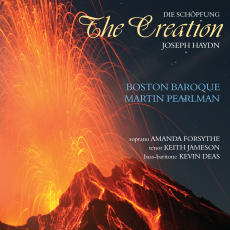Boston Baroque - Haydn Creation - International Record Review
The striking cover photograph of an erupting volcano at night is carried over into the booklet, whose text is printed in white on a dark background. This makes for handsome presentation...A useful introductory by the conductor and information about the performers are also provided. The recorded sound is rich, clear and lifelike, though if soloists are often placed too far forward for your taste, you might find that here too. The first two parts of the work are placed uninterrupted on the first SACD, with the final part on the second.
Boston Baroque, as the name suggests, uses period instruments. Recitatives are accompanied by a fortepiano. The hefty wind section required by Haydn's extraordinarily vivid orchestration is balanced by strings fairly restrained in number - six first violins, for example, and two double basses. Twenty-five singers make up the choir. In his booklet essay, the conductor explains that in as least one performance conducted by Haydn himself the choir and orchestra were even smaller than here. He also points out that Haydn is reported to have preferred ‘quick, vigorous tempos'. Martin Pearlman has had access to old manuscript parts used by soloists and has incorporated some of the ornamentation noted therein - discreet, musical and extremely effective - into this performance. The use of three soloists only, rather than the five favoured by some conductors, is defended by pointing out that this was always the case in composer-conducted performances.
Amanda Forsythe has a most pleasing voice, bright, clear and readily communicative. She has the agility required...and there is a smile in her voice that is very winning. There are moments when Keith Jameson's voice bears an uncanny resemblance to that of Wilfred Brown, a happy association for this listener. He gets right inside the text, his singing most musical, with a particularly satisfying legato line. Bass-baritone Kevin Deas is at home in the higher reaches of the part, which is surprising given the presence and power of his lower notes, including an unauthorized but irresistible bottom D when evoking the ‘sinuous' worm. There are times when he might have brought more variety of colour to his singing - the animals in this same recitative could have been more vividly conjured up, for example - but this is nonetheless an assured performance.
The chorus is alert, expert and certainly makes itself heard. Indeed, choir/orchestra balance is ideal, allowing many passages to be properly imposing and monumental. The orchestral playing is pretty much vibrato-free - though the soloists are allowed a little, very tasteful and controlled - and the playing is skilful and sensitive with some attractive work from the wind soloists, for whom this work is a gift...
In all, this is a delightful, charming and often moving performance on a smallish scale...

